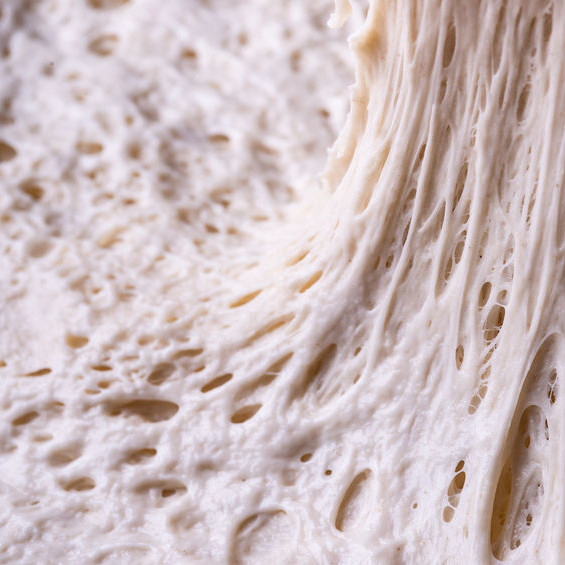Vital Wheat Gluten
Also known as gluten
What is Vital Wheat Gluten?
Vital wheat gluten, or simply VWG, is a highly functional protein that has been separated from wheat starch and other grain components. It is used almost exclusively in high-speed bakeries to improve dough strength and provide additional dough tolerance to processing variations, mainly fermentation times and temperatures.
- Usage levels of VWG range from 1.0 to 4.0% (based on flour weight) for most yeast-raised doughs.
- However, it can go as high as 12.0% in high fiber breads.
Origin
This protein is found in wheat, barley, oats, rye and triticale. As a storage protein, it provides a reserve of amino acids for the developing seedling when germination occurs.1
Utilization of vital wheat gluten expanded in the 1950s with the rise of large-scale bakeries which required the highest volumes regardless of flour quality variations due to wheat crop changeovers. Alongside potassium bromate, VWG soon became the biggest ally for bakers seeking the highest levels of production reliability.
Function
Vital wheat gluten consists mainly of gliadin and glutenin, key proteins which have the unique ability to form a cohesive and viscoelastic polymeric network that is capable of retaining gases entrapped in it.
A wide range of functionalities in bread and bun formulations are attributed to VWG. The following are some of these functions:
- Increases P/L value in Alveograph test
- Reduces gas bubble coalescence
- Increases colloidal stability of fermented/proofed doughs
- Increases gas retention capacity of dough and subsequently increases product volume
- Enhances nutritional profile of finished product (a 1.0% addition of VWG will increase the flour protein content by 0.6%)
- Its addition allows bakers to increase water absorption (a 1.0% addition of VWG will increase dough absorption by about 1.5%)
- Improves mixing and fermentation tolerances
Commercial production
From a manufacturing perspective, vital wheat gluten is a wheat flour protein material that has been separated from starch and most fibers, then dried carefully with a minimum amount of heat in order to preserve its vitality (i.e. preventing proteins from denaturing and losing their aggregation properties). Temperatures above 55°C (131°F) can adversely affect the functionality.
The product comes as a dry powder. Commercial vital wheat gluten is roughly 73% protein (78% dry basis), 6% total fat, 6% moisture and <1% ash.3
Application
The addition of VWG generally increases the dough mixing time and fermentation time. As more protein solids are added, more water is needed for complete flour hydration.
Due to its cohesive and viscoelastic properties, it’s main function is a dough strengthener. It is also a film former, binder, texturizer, fat emulsifying agent, processing aid, stabilizer, water absorption and retention agent, thermosetting agent, and a flavor and color binder.
Vital gluten can absorb almost twice its weight in water (140–180% water). The quality of dry vital gluten is estimated with the Brabender farinograph or Chopin Alveograph. The breadmaking quality of VWG is also assessed through standardized baking tests.
Regulation
VWG holds a GRAS status by the FDA and thus can be used in food with no limitation other than current good manufacturing practice. Similar to other sources, it is not suitable for people with gluten-related disorders.
Similar regulations for VWG usage In the EU and should comply with EU directive 178/2002/EC.4
References
- Shewry, P.R., D’Ovidio, R., Lafiandra, D., Jenkins, J.A., Clare, Mills, E.N., and Békés, F. “Wheat Grain Proteins.” Wheat Chemistry and Technology, 4th edition, AACC International, Inc., 2009, pp. 223–298.
- De Leyn, I. “Other Functional Additives.” Bakery Products Science and Technology, 2nd edition, John Wiley & Sons, Ltd, 2014, pp. 298–299.
- Federal Register: Electronic Code of Federal Regulations, Title 21, Chapter I, Subchapter B, Part 184 – Direct Food Substances Affirmed as Generally Recognized as Safe, https://www.accessdata.fda.gov/scripts/cdrh/cfdocs/cfcfr/CFRSearch.cfm?fr=184.1322, Accessed 2 April 2021.
- https://eur-lex.europa.eu/legal-content/EN/TXT/PDF/?uri=CELEX:02002R0178-20140630&rid=1


